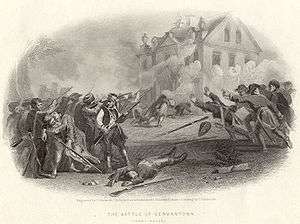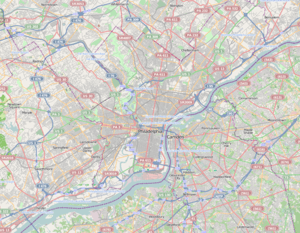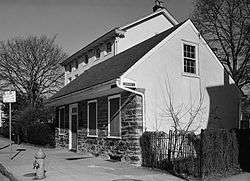Colonial Germantown Historic District
|
Colonial Germantown Historic District | |
 | |
   | |
| Location |
Both sides of Germantown Avenue, between Windrim Avenue and Sharpnack Street Philadelphia, Pennsylvania |
|---|---|
| Area | 113 acres (46 ha) |
| Built | 1683 |
| Architect | Multiple |
| Architectural style | Colonial, Georgian, Federal |
| NRHP Reference # | 66000678[1] |
| Significant dates | |
| Added to NRHP | October 15, 1966[2] |
| Designated NHLD | June 23, 1965[3] |
The Colonial Germantown Historic District is a designated National Historic Landmark District in the Germantown and Mount Airy neighborhoods of Philadelphia, Pennsylvania along both sides of Germantown Avenue. This road followed an Indian path from the Delaware River just north of Old City Philadelphia, through Germantown, about 6 miles northwest of Center City Philadelphia, and on to Pottstown. Settlement in the Germantown area began, at the invitation of William Penn, in 1683 by Nederlanders and Germans under the leadership of Francis Daniel Pastorius fleeing religious persecution.[2][4][5]
Colonial Germantown was a leader in religious thought, printing, and education. Important dates in Germantown's early history include:[6]
- August 16, 1683, Pastorius arrives in Philadelphia
- October 25, 1683, Lots are drawn for land among Pastorius's followers and settlement begins
- 1688, first American anti-slavery protest published
- 1690, first paper-mill built in America is built near Germantown
- 1705, possibly the first portrait painted in oil in America painted by Christopher Witt in Germantown
- 1708, first Mennonite Meetinghouse in America built in Germantown
- 1719, first Dunkards in America arrive in Germantown
- 1743, first Bible printed in America in any European language (in this case German), printed by Christoph Sauer
- 1760, Germantown Academy founded
- 1762, invasion of the Paxton Boys
- 1770, first American book on pedagogy written by Christopher Dock and published in Germantown
- October 4, 1777, Battle of Germantown
- 1793, during the Philadelphia Yellow Fever Epidemic, President Washington and his cabinet move to Germantown
- 1794, Washington spends two months in Germantown to avoid the heat in Philadelphia
- July 20, 1825, General Lafayette visits Germantown
- June 6, 1832, railroad from Philadelphia to Germantown opens
Historic designation and extent
The district was designated a National Historic Landmark in 1965 and was added to the National Register of Historic Places in 1966. The original district included the 4500 to 6600 blocks of Germantown Avenue (between Windrim Avenue and Sharpnack Street). In 1987 the district was expanded north to the 7600 block of Germantown Avenue (up to Cresheim Valley Drive), which is the southern boundary of the Chestnut Hill Historic District. The district's two parts contain 579 properties, of which 514 are considered contributing, and only 65 non-contributing. The northwest Philadelphia area, which promotes itself as "Freedom's Backyard,"[7] contains 11 historic districts listed by the National Register of Historic Places, as well as 58 separately listed properties.[8] Eight state historical markers are located on Germantown Avenue. Nearly complete inventories prepared for the National Register of Historic Places, both for the original district and for the expanded area are available.[9][10] A 1907 inventory of historic buildings in the area was printed in the "History of Old Germantown."[11]
Selected contributing properties
Contributing properties in the district include the following. Even street numbers are on the west side of Germantown Avenue, odd numbers on the east. Original construction dates may be approximate.
| Name | Image | Address | Date | Note |
|---|---|---|---|---|
| Loudoun Mansion | 4650 Germantown Ave. 40°01′32″N 75°09′39″W / 40.0256°N 75.1607°W |
1801 | Built by Thomas Armat, additions 1829, 1850, 1888, rehab 1864. Stucco on rubble with wood trim. Federal style. | |
| C. W. Schaeffer Public School | |
4701 Germantown Ave. 40°01′36″N 75°09′38″W / 40.0267°N 75.1605°W |
1876 | Listed separately on NRHP. Three stories in stone with wood trim. Designed by L. Esler in the Italianate style. |
| Mehl House |  |
4821 Germantown Ave. 40°01′41″N 75°09′41″W / 40.0280°N 75.1615°W |
1744 | Stone with wood trim in the Federal style. Brick ell built in 1933. |
| Ottinger House | |
4825 Germantown Ave. 40°01′41″N 75°09′42″W / 40.0281°N 75.1616°W |
1748 | Colonial and Federal styles. |
| Lower Burial Ground | |
4901–21 Germantown Ave. 40°01′44″N 75°09′44″W / 40.0289°N 75.1621°W |
1692 | Now called Hood Cemetery. Baroque Revival style entry gate designed in 1849 by William L. Johnston. |
| Baynton House | |
5208 Germantown Ave. 40°01′52″N 75°10′04″W / 40.0310°N 75.1677°W |
1798 | Two and one-half stories. Brick with stone and wood trim in the Federal style. |
| Conyngham-Hacker House | |
5214 Germantown Ave. | 1796 | Listed separately on the NRHP. Two and one-half stories. Stone with wood trim in the Federal style. |
| Howell House | |
5218 Germantown Ave. | 1798 | Listed separately on the NRHP. Built for William Forbes. Two and one-half stories. Stone with wood trim in the Federal style. |
| Theobald Endt House | |
5222 Germantown Ave. | 1730. Rebuilt 1802. | AKA Handsberry House; built by Theobald Endt. Two and one-half stories. Stucco on stone with wood trim in the Federal style. |
| Bechtel House | |
5226 Germantown Ave. | 1730 Rebuilt 1802 |
Once the home of Rev. John Bechtel. Two and one-half stories. Stone with wood trim in the Colonial style. |
| Grumblethorpe | |
5267 Germantown Ave. 40°01′56″N 75°10′06″W / 40.0322°N 75.1683°W |
1744 | Listed separately on NRHP. Additions in 1750, 1799, 1806, 1819. Owned by John Wister, an important site during the Battle of Germantown. Stone with wood trim in the Colonial style. |
| Wistar's Tenant House | |
5269 Germantown Ave. | 1745 | Listed separately on NRHP. Addition in early nineteenth century. Stone with wood trim in Colonial style. |
| Clarkson-Watson House | 5275 Germantown Ave. | 1745 | Additions/alterations in 1775, 1825, 1870, 1910. Stucco on stone with wood trim in Federal style/Colonial style. | |
| Germantown Friends School and Meeting House |
 |
5400 Germantown Ave. 40°01′57″N 75°10′19″W / 40.0325°N 75.1719°W |
1869 | Meeting founded 1690. This parcel acquired 1693 and used as a burial ground. Previous meeting houses built 1705, 1812. School founded 1845. Several school buildings on site. |
| Masonic Temple of Germantown | |
5423–27 Germantown Ave. | 1873 | Additions/alterations 1915, 1920. Three stories, stone with wood trim in the Gothic Revival style A previous house on this site was the birthplace of Louisa May Alcott. |
| Germantown White House |  |
5442 Germantown Ave. 40°02′02″N 75°10′18″W / 40.0338°N 75.1718°W |
1772 | Listed separately on the NRHP. AKA the Deshler-Morris House. Additions/alterations 1840, 1856, 1868, 1887, 1898, 1909. HQ of General Howe during Battle of Germantown. Temporary residence of President George Washington 1793-94. Stucco on stone with wood trim in the Federal style. |
| National Bank of Germantown | |
5500–04 Germantown Ave. 40°02′03″N 75°10′23″W / 40.0343°N 75.1730°W |
1868 | J.C. Sidney original architect. Additions/alterations 1890, 1907, 1930. Stone with wood trim in the Renaissance Revival style. |
| John Fromberger House |  |
5501 Germantown Ave. 40°02′04″N 75°10′19″W / 40.0345°N 75.1719°W |
1796 | Multiple renovations; now houses the Germantown Historical Society. Brick with stone and wood trim in the Federal style. |
| S.S. Kresge Store | |
5549-53 Germantown Ave. 40°02′06″N 75°10′24″W / 40.0350°N 75.1734°W |
Georgian Revival style | |
| Loyal Order of Odd Fellows | |
5615 Germantown Ave. 40°02′08″N 75°10′27″W / 40.0356°N 75.1741°W |
1860 | New facade 1940. Three stories in brick with stone and pressed metal in the Georgian Revival style. |
| C. A. Rowell Department Store | |
5627 Germantown Ave. | 1949 | Rear section originally Germantown Trust (1929). Georgian Revival style by architect Herbert Beidler. |
| First Presbyterian Church in Germantown |
|
5700 block Germantown Ave. (35 West Chelten Ave.) 40°02′06″N 75°10′31″W / 40.035°N 75.1754°W |
1871+ | Attributed to architect T. Roney Williamson, Richardson Romanesque style |
| Vernon-Wister House | |
5708 Germantown Ave. 40°02′09″N 75°10′36″W / 40.0357°N 75.1766°W |
1803 | Federal style, purchased by John Wister, grandson of Wister at Grumblethorpe |
| Vernon Park branch The Free Library of Philadelphia |
|
5708 Germantown Ave. 40°02′11″N 75°10′35″W / 40.0365°N 75.1764°W |
1907 | Now housing the Center in the Park.org. A Carnegie Library; designed by Frank Miles Day & Brother |
| Germantown Townhall | |
5900 block Germantown Ave. | Never actually served as the town hall[12] | |
| Wyck House | |
6026 Germantown Ave. 40°02′24″N 75°10′43″W / 40.0399°N 75.1785°W |
1690 (part) | Listed separately as a National Historic Landmark. 1824: remodeled by William Strickland |
| Mennonite Meetinghouse | |
6119 Germantown Ave. 40°02′29″N 75°10′45″W / 40.0413°N 75.1791°W |
1770 | Listed separately on the NRHP. Congregation established in 1688 as first Mennonite church in America. One and one-half stories, stone with wood trim in the Colonial style. |
| John Johnson House | |
6306 Germantown Ave. | 1768 | Listed separately as a National Historic Landmark. A stop on the Underground Railroad. After 1918, home of the Women's Club of Germantown. |
| Concord School House |  |
6309 Germantown Ave. 40°02′38″N 75°10′52″W / 40.0440°N 75.1811°W |
1775 | Possibly built by Jacob Knor. Two and one-half stories, stone with wood trim. |
| Upper Burial Ground | |
6311–17 Germantown Ave. | 1693 | "Axe's Cemetery," land donated by Paul Wolfe, wall built 1777. |
| Cliveden |  |
6401 Germantown Ave. 40°02′47″N 75°10′56″W / 40.0465°N 75.1821°W |
1763-67 | Listed separately as a National Historic Landmark. Estate of Benjamin Chew, an important site during the Battle of Germantown. Built by William Knor. Two and one-half stories with wood trim in the Colonial style. |
| Upsala | |
6430 Germantown Ave. 40°02′48″N 75°11′00″W / 40.0467°N 75.1832°W |
1798 | Listed separately on the NRHP. Two and one-half stories with wood trim in the Federal style. Rear sections perhaps built earlier. |
| Daniel Billmeyer House | |
6504 Germantown Ave. 40°02′54″N 75°11′01″W / 40.0484°N 75.1837°W |
1793 | Listed separately on the NRHP. Stone with wood trim in the Federal style. |
| Michael Billmeyer House | |
6505 Germantown Ave. 40°02′55″N 75°11′00″W / 40.0485°N 75.1834°W |
1727 | Listed separately on the NRHP. Stone with wood trim in the Federal and German colonial styles. |
| Church of the Brethren | |
6611 Germantown Ave. 40°03′00″N 75°11′03″W / 40.0501°N 75.1841°W |
1770 | First Church of the Brethren (Dunkards) in America |
| Winston Commons | |
6620–24 Germantown Ave. 40°03′04″N 75°11′06″W / 40.0510°N 75.1851°W |
1895 | Architect William Lightfoot Price |
| St. Michael's Lutheran Church in Germantown | |
6671 Germantown Ave. 40°03′08″N 75°11′05″W / 40.0521°N 75.1846°W |
1896-97 | The congregation has used this site at least since 1728. |
| Beggarstown School |  |
6669 Germantown Ave. 40°03′05″N 75°11′06″W / 40.0514°N 75.1850°W |
1740 | Listed separately on the NRHP. |
| Mt. Airy Presbyterian Church | |
7108 Germantown Ave. 40°03′31″N 75°11′24″W / 40.0585°N 75.1899°W |
1880 | |
| Sedgwick Theater | |
7133-41 Germantown Ave. 40°03′31″N 75°11′24″W / 40.0585°N 75.1899°W |
1926-1928 | Art Deco. William H. Lee architect. |
| Tourison Building | |
7200-06 Germantown Ave. 40°03′31″N 75°11′24″W / 40.0585°N 75.1899°W |
1920s | Art Deco. Tunis and Baker, architects. |
| Store | |
7203 Germantown Ave. 40°03′39″N 75°11′27″W / 40.0608°N 75.1909°W |
||
| Mt. Airy Agricultural School | |
7331 Germantown Ave. 40°03′41″N 75°11′30″W / 40.0614°N 75.1916°W |
1792 | |
| Cresheim Cottage | |
7402-04 Germantown Ave. 40°03′45″N 75°11′36″W / 40.0626°N 75.1933°W |
1804? | |
| Bockius House | |
7413 Germantown Ave. 40°03′48″N 75°11′34″W / 40.0634°N 75.1929°W |
1790-1800 | |
See also
- Awbury Historic District
- Chestnut Hill Historic District
- RittenhouseTown Historic District
- Tulpehocken Station Historic District
References
- ↑ National Park Service (2007-01-23). "National Register Information System". National Register of Historic Places. National Park Service.
- 1 2 Listing at the National Park Service
- ↑ "Colonial Germantown Historic District". National Park Service. Retrieved 2010-12-03.
- ↑ NRHP 1966? Nomination Form Enter "public" for ID and "public" for password to access the site.
- ↑ NRHP 1987? Nomination Form Enter "public" for ID and "public" for password to access the site.
- ↑ Jenkins, Charles Francis (1902). The guide book to historic Germantown. Germantown: Site and relic society. p. 170. p. 7
- ↑ FreedomsBackyard.com accessed November 1, 2010.
- ↑ Philadelphia Historic Resource Survey Inventory, Preservation Alliance for Greater Philadelphia, Philadelphia, Pennsylvania, January 2007, p. 42
- ↑ NRHP 1966? Inventory Enter "public" for ID and "public" for password to access the site.
- ↑ NRHP 1987? Inventory Enter "public" for ID and "public" for password to access the site.
- ↑ Garber, John Palmer; Naaman Henry Keyser; C. Henry Kain; Horace Ferdinand McCann (1907). History of Old Germantown. Germantown: H. F. McCann. p. 453.
- ↑ "Germantown Town Hall". Hidden City Philadelphia/Vimeo. Retrieved May 28, 2013.
Further reading
- Anderson, Elijah (1999). Code of the street: decency, violence, and the moral life of the inner city. W. W. Norton & Company. p. 352. ISBN 0-393-32078-2, ISBN 978-0-393-32078-7. Sociological study set on Germantown Avenue
- Keyser, Naaman H.; C. Henry Kain; John Palmer Garber; Horace Ferdinand McCann (1907). History of old Germantown: with a description of its settlement and some account of its important persons, buildings and places connected with its development, Volume 1. Germantown, Philadelphia: H. F. McCann. p. 453.
- Pennypacker, Samuel (1899). The Settlement of Germantown Pennsylvania and the Beginning of German Emigration to North America. Philadelphia: William J. Cambell. p. 311.
External links
| Wikimedia Commons has media related to Colonial Germantown Historic District. |
- 1982 National Register of Historic Places Inventory--Nomination Form, Addendum to Colonial Germantown Historic District at Bryn Mawr College
- "Germantown Street Index". Places in Time: Historical Documentation of Place in Greater Philadelphia. Bryn Mawr College. Retrieved August 2010. Check date values in:
|access-date=(help) at Bryn Mawr College - Carl E Doebley; Mark Lloyd (December 10, 1982). "Germantown: Colonial Germantown Historic District". LivingPlaces.com. Retrieved July 2010. Check date values in:
|access-date=(help)
Videos
- Germantown History, 2010, VisitPhilly, YouTube.
- Down Germantown Avenue, Part One, 2007, James Flatley and Etienne Jackson with Robert Wood, YouTube. Student film travels from Chestnut Hill south.
- Down Germantown Avenue, Part Two, 2007, James Flatley and Etienne Jackson with Robert Wood, YouTube. From Chelten Avenue south

